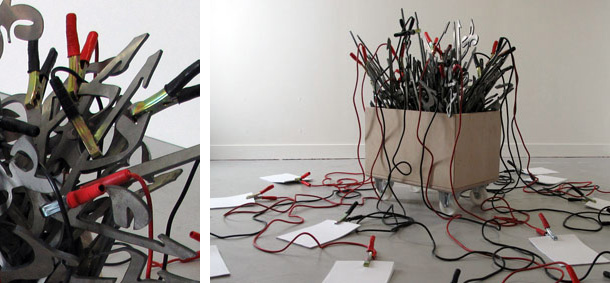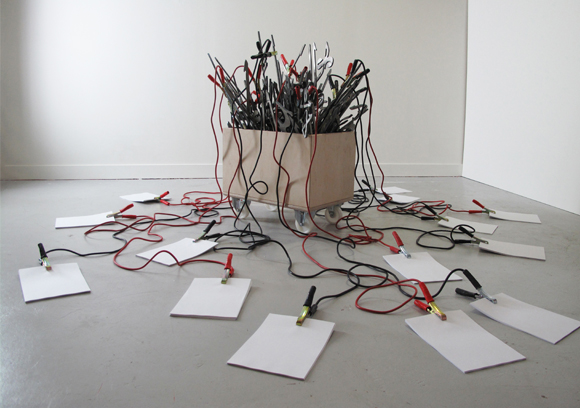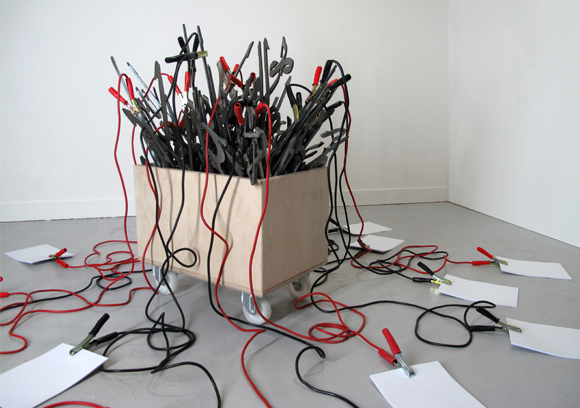| |
|
|
41.
| The Awakening Day |
| |


2011, 110 x 250 x 200, Arabic calligraphy in steel, wooden box, starter cables, paper.
Exhibition view of FIAC, 2011, Paris.
Courtesy of the artist and Ceysson & Bénétière, Paris.
Ed. of 5 + 1 A.P.
The Awakening Day gathers fragments – pieces of paper, lettering, individuals – that separately don’t have any impact but,
when connected in the violence of electric shocks transmitted by the cables, tend to become cogs in a complex machine.
Studio Fatmi, February 2017

The Awakening Day
Exhibition view of FIAC, 2011, Paris.
Courtesy of the artist and Ceysson & Bénétière, Paris.

The Awakening Day
Exhibition view of FIAC, 2011, Paris.
Courtesy of the artist and Ceysson & Bénétière, Paris.
|
|
|
|
|
| Collection of The Tiroche DeLeon Collection, Israel
L’installation Le Jour du Réveil, est un assemblage hétéroclite de matières plastiques, métalliques et végétales. Le dispositif relie au moyen de câbles électriques des feuilles de papier blanc et vierge à des lettres de calligraphie arabe découpées au laser dans des plaques de métal puis entassées dans une caisse en bois montée sur des roulettes. Sa désignation, simple et énigmatique est une indication temporelle d'un événement, ou slogan révolutionnaire, ne fait qu'ajouter au mystère de cette installation participative.
Avec le Jour du Réveil, Mounir Fatmi examine les conditions matérielles des grands bouleversements culturels et tente de mettre au point un dispositif capable de les reproduire en étudiant les rôles joués par le langage et l'individu dans les conditions d'interactions culturelles fortes et impliquant des instances très différentes, et à priori difficilement compatibles. De tels dispositifs expérimentaux combinant un langage et une machine ou traitant de la rencontre entre deux cultures s'observent ailleurs dans l'œuvre de Mounir Fatmi : l'Index et La Machine qui évoque la naissance de l'imprimerie et son rôle majeur dans la diffusion des idées et leur contrôle, Le Paradoxe, qui étudie les conditions de l'apparition de la pensée critique et autonome, ou encore la vidéo Technologia qui fait se rencontrer la calligraphie arabe et l'art contemporain, en sont des exemples.
Le Jour du Réveil accumule les fragments -morceaux de papier, lettrages, individus- qui séparément n'ont aucune action mais qui, reliés dans la violence des chocs électriques transmis par les câbles électriques, tendent à devenir les rouages d'une machine complexe. Les motifs calligraphiques qui semblent avoir été détachés du contexte d’où ils se trouvaient par une force considérable décrivent alors un langage rendu à sa liberté et à son pouvoir critique. L'hybridation des matériaux et des techniques préfigure celle des cultures et des modes de pensée à venir. Et cette dernière n'a pas qu'une simple valeur symbolique dans l'œuvre présentée par Mounir Fatmi. Elle contribue à la double élaboration d'une esthétique de la bizarrerie et du drame aux enjeux et aux effets décisifs. D'un côté la curiosité et l'énigme exercent leur séduction sur le spectateur et cherchent à lui transmettre le goût de l'expérimentation. De l'autre, une mise en scène dramatique jouant sur les contrastes produit une représentation d'un bouleversement historique qui dit l'urgence de libérer les modes de pensées.
Studio fatmi, Février 2017.
|
|
The installation The Awakening Day is a heterogeneous assemblage of plastic, metallic and vegetal materials. The setup connects white sheets of paper to letters in Arab calligraphy using electric cables, the letters having been laser cut out of metal sheets and piled up in a wood box with wheels. Its simple and enigmatic title is the temporal indication of an event or revolutionary slogan, and only adds to the mystery of this participative installation.
With The Awakening Day, Mounir Fatmi examines the material conditions of great cultural shifts and tries to create an apparatus that could reproduce them by studying the roles of language and individuals in conditions of strong cultural interactions involving very different and seemingly hardly compatible instances. Such experimental installations combining a language and a machine or addressing the encounter between two cultures can be found in other works by Mounir Fatmi, such as The Index and The Machine, which evokes the birth of the printing press and its major role in the propagation of ideas and their control, or The Paradox, which studies the conditions of the appearance of critical and independent thinking, as well as in the video Technologia, in which Arabic calligraphy collides with contemporary art.
The Awakening Day gathers fragments – pieces of paper, lettering, individuals – that separately don’t have any impact but, when connected in the violence of electric shocks transmitted by the cables, tend to become cogs in a complex machine. The calligraphic motifs, that seem to have been detached from the context where they were by a considerable force, represent a language to which freedom and the power of criticism have been returned. The hybridization of materials and techniques heralds that of cultures and ways of thinking. And this doesn’t just have a symbolic value in the work presented by Mounir Fatmi. It contributes to the elaboration of both an esthetic of strangeness and a drama with decisive stakes and effects. On one side, curiosity and enigma seduce the viewer and convey a penchant for experimentation. On the other, the dramatic staging relying on strong contrasts produces the representation of an historic shift that states the urgency of setting ways of thinking free.
Studio Fatmi, February 2017.
|
|
|
|